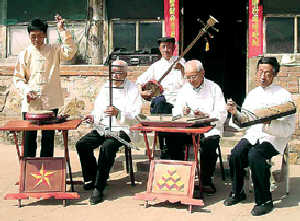Beijingdagu shu (singing-storytellingor ballad-signing performance, also known asquyi), popular in the beginning of the 20th century, originated from two directions: Beijing's east, which is the birthplace of Jingdond dagu, and the south of Beijing, including Langfang, Bazhou, Cangzhou, and Jianhe, which produced Xihe dagu and Cangzhou Muban dagu.
In the last stage of the Qing Dynasty (1644-1911), Leting dagu and Xihe dagu spread to Beijing and attracted many audiences. The original Muban dagu that passed to Beijing did not become deeply rooted because of its strong local dialect. However, with the effort of some Beijing and Tianjin's actors, like Hu Shi, Song Wu, and Huo Mingliang, the former Muban dagu became Jingyun dagu, which brought up two great artists, the king of drum, Liu Baoquan, and the lord of Jingyun dagu, Bai Yunpeng.
That splendid period has been gone for more than one hundred years.
 Wuyin Dagu
Wuyin Dagu
 Location: Wumudi of Miyun County
Location: Wumudi of Miyun County
Artists: Qi Dianzhang (79 years old), Qi Dianming (71), Li Maosheng (60), Chen Zhenquan (63), Jia Yunming (64)
Wuyin dagu, also called " Miyun's Naxi guyue"(Miyun's Naxi Ancient Music), was created at Wumudi in rural Beijing's Miyun County, where this endangered folk art is transmitted from generation to generation.
According to experts, Wuyin dagu originated in the countryside of present Hebei Province of North China in the time of the Qing Emperor Daoguang's reign (1821-1851). Wuyin dagu is a part of the dagu family, a division of shuochang or singing-storytelling performance in which the singer accompanies himself or herself with a drum and ban (a percussion instrument made of two wooden boards).
The most famous of the other schools of dagu include Jingyun dagu and Xihe dagu, where the performer sings and talks in local Beijing dialect.
Related:Finding the Root of Beijing Dagu Shu(II)
